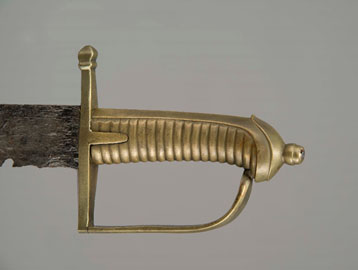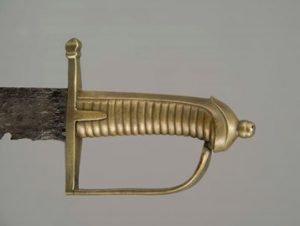Spotlight on DHR Collections: Kingsmill 'Artillery of Virginia’ Sword


Not all the artifacts in the DHR Collections derive from archaeological investigations at recorded sites. Some very important artifacts are the result of isolated finds. For instance, in the mid-1970s a construction worker at Kingsmill Estates—once part of the Kingsmill Plantation established in the early 1600s in present-day James City County—sat down under a tree for his lunch break and noticed protruding from the tree’s roots part of a “short sword,” the well-preserved artifact highlighted here.
Such swords were imported to Virginia during the Revolutionary War, after Gov. Patrick Henry tasked commercial agents with procuring weapons and tools from France to supplement Virginia’s home production. One such agent, Jacques LeMaire, contracted with Klingenthal, a sword manufacturer near Strasbourg, France, for horseman’s sabres, the principal arm of the Virginia Militia’s light cavalry, and shorter weapons for the Artillery and Grenadiers. These short swords had a heavy, slightly curved blade and a two-piece brass hilt and were carried in brass-tipped leather scabbards. This “Artillery of Virginia” sword and other imported sabres remained in use long after the 1776-1781 conflict.

If you wonder why the sword's brass hilt appears so well preserved compared to the iron blade, it is due largely to “galvanic corrosion,” a process by which noble metals—e.g. gold, silver, and copper—corrode at different rates than base metals—e.g. nickel, iron, and zinc. Moreover, not only do the metals corrode at different rates but when they are in contact with each other the base metal sacrifices electrons that allow the noble metal to remain more stable over time. So, in this case the blade of iron corroded more rapidly as it gave up electrons to the brass hilt.
This sword, now in DHR’s Collections, will be featured in the exhibit “Arming Virginia, Weapons for the Revolution,” scheduled to open in April, 2019 at The Museums of Colonial Williamsburg.
Thanks to archaeologists Nick Luccketti and Erik Goldstein for information about the sword and to the Colonial Williamsburg Foundation for the images.
For more on sabres and short swords, see G. Cromwell: http://ehcnc.org/decorative-arts/historic-trades/french-swords-for-virginia-1779-redux/.
--Dee DeRoche, Chief Curator, DHR, with contributions by Katherine Ridgway, Conservator, DHR










